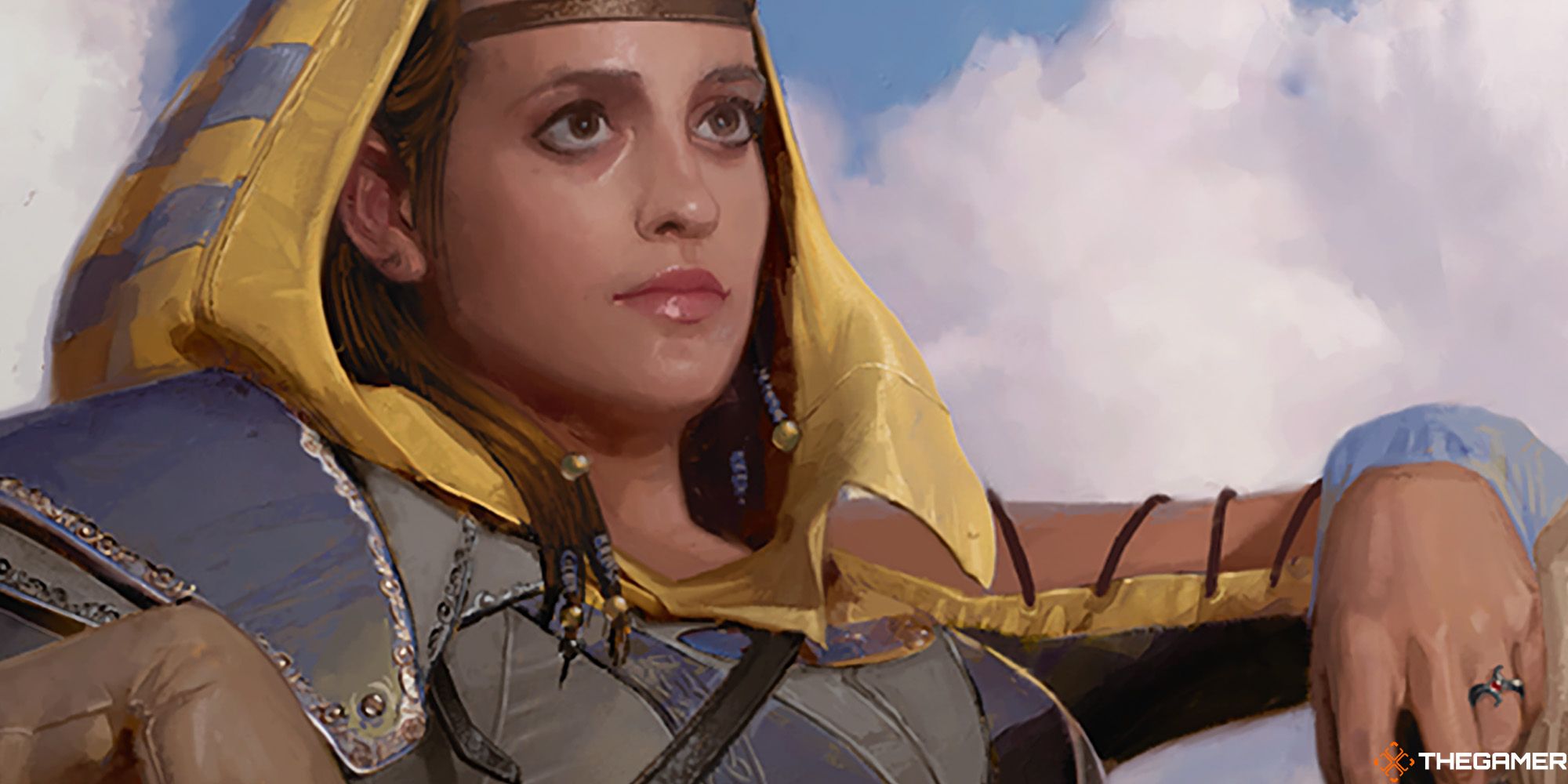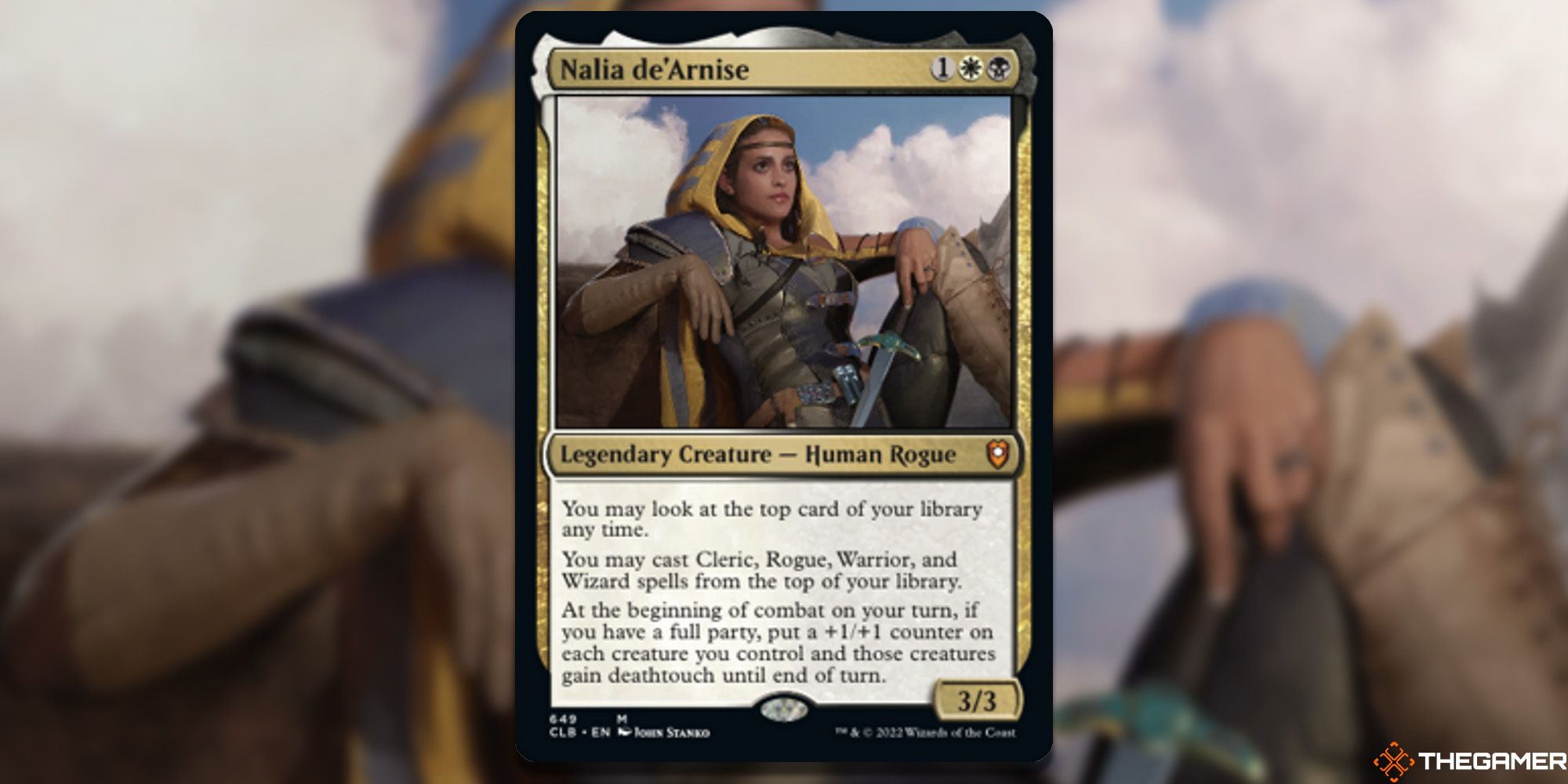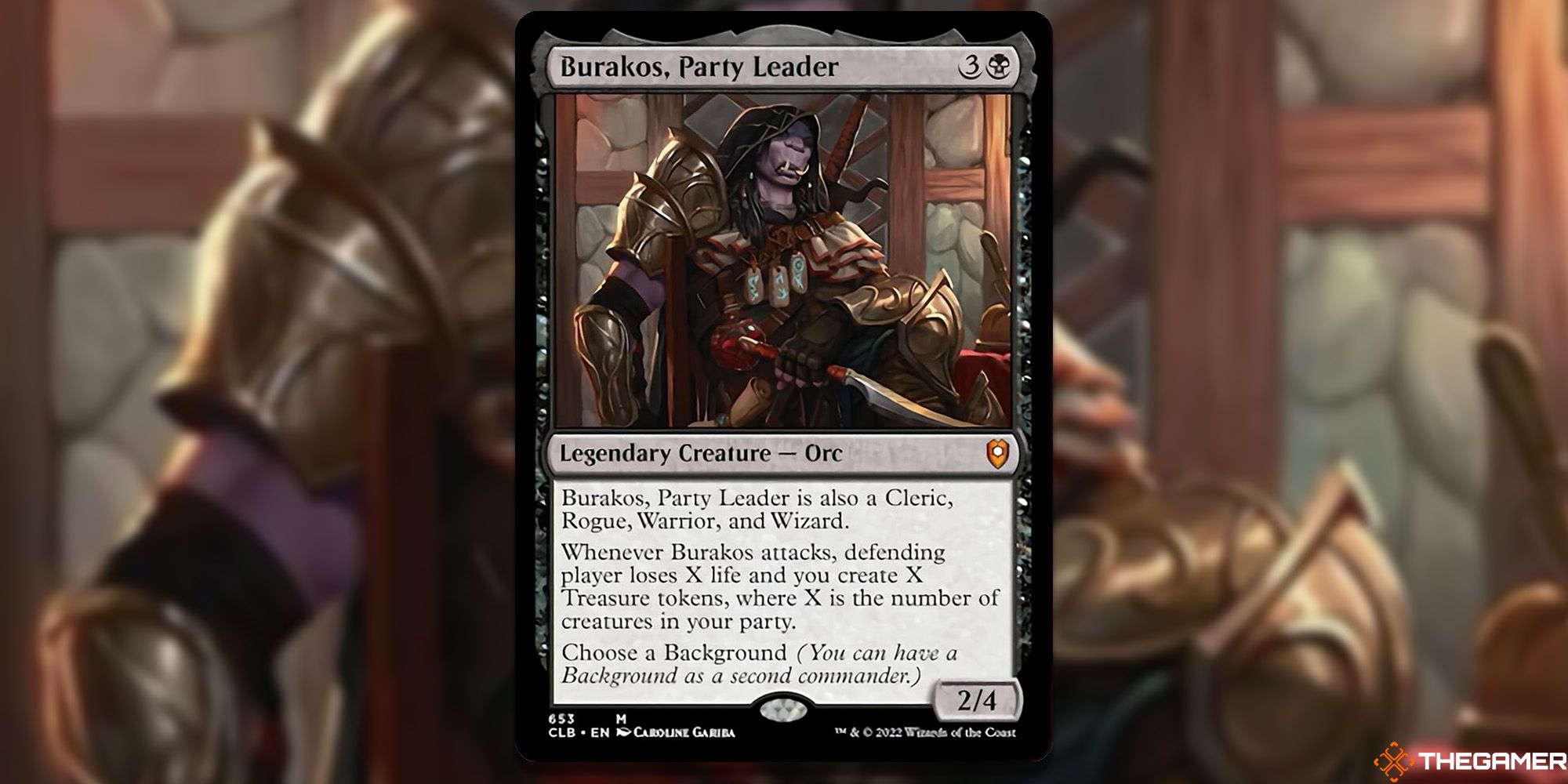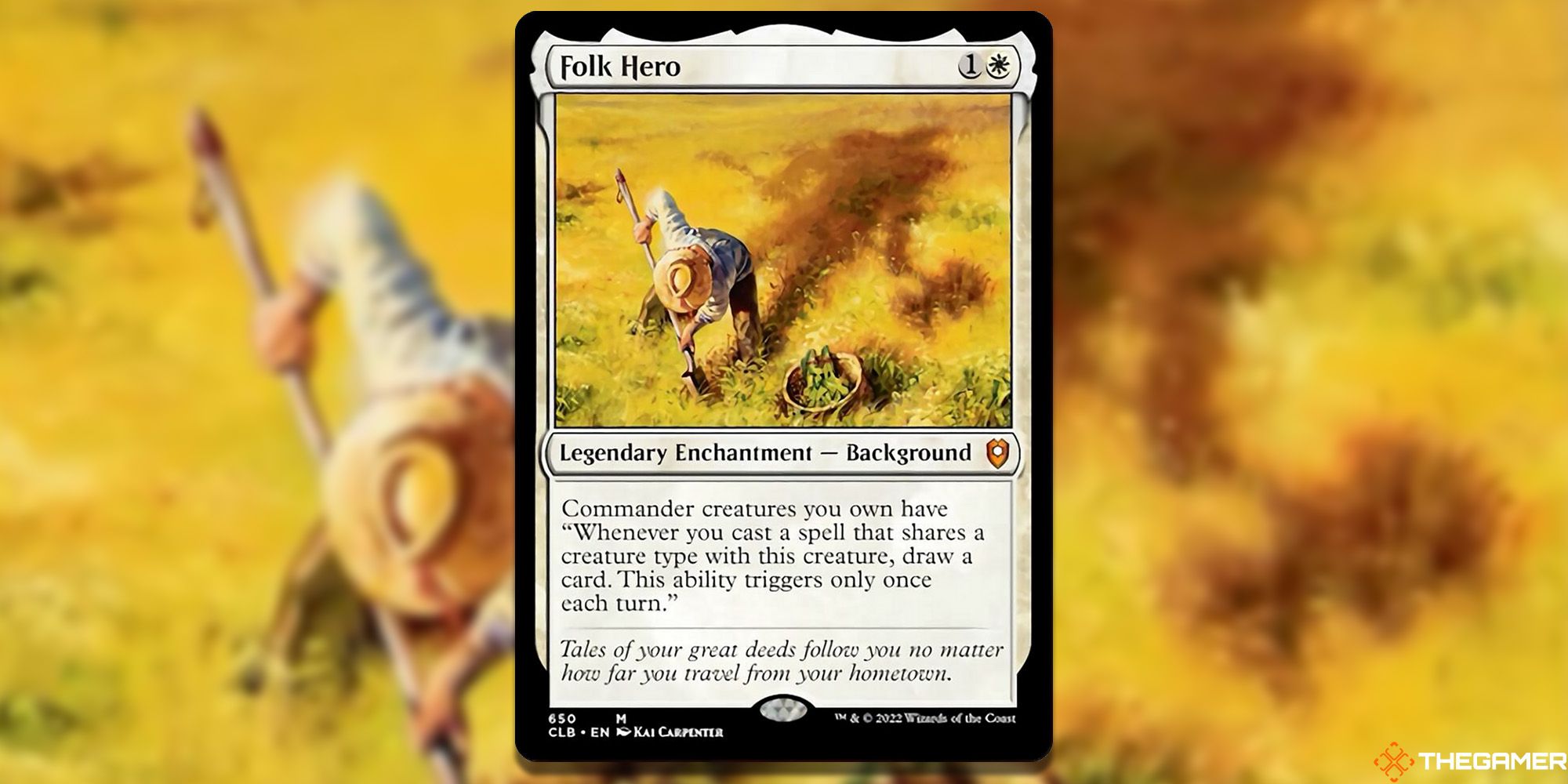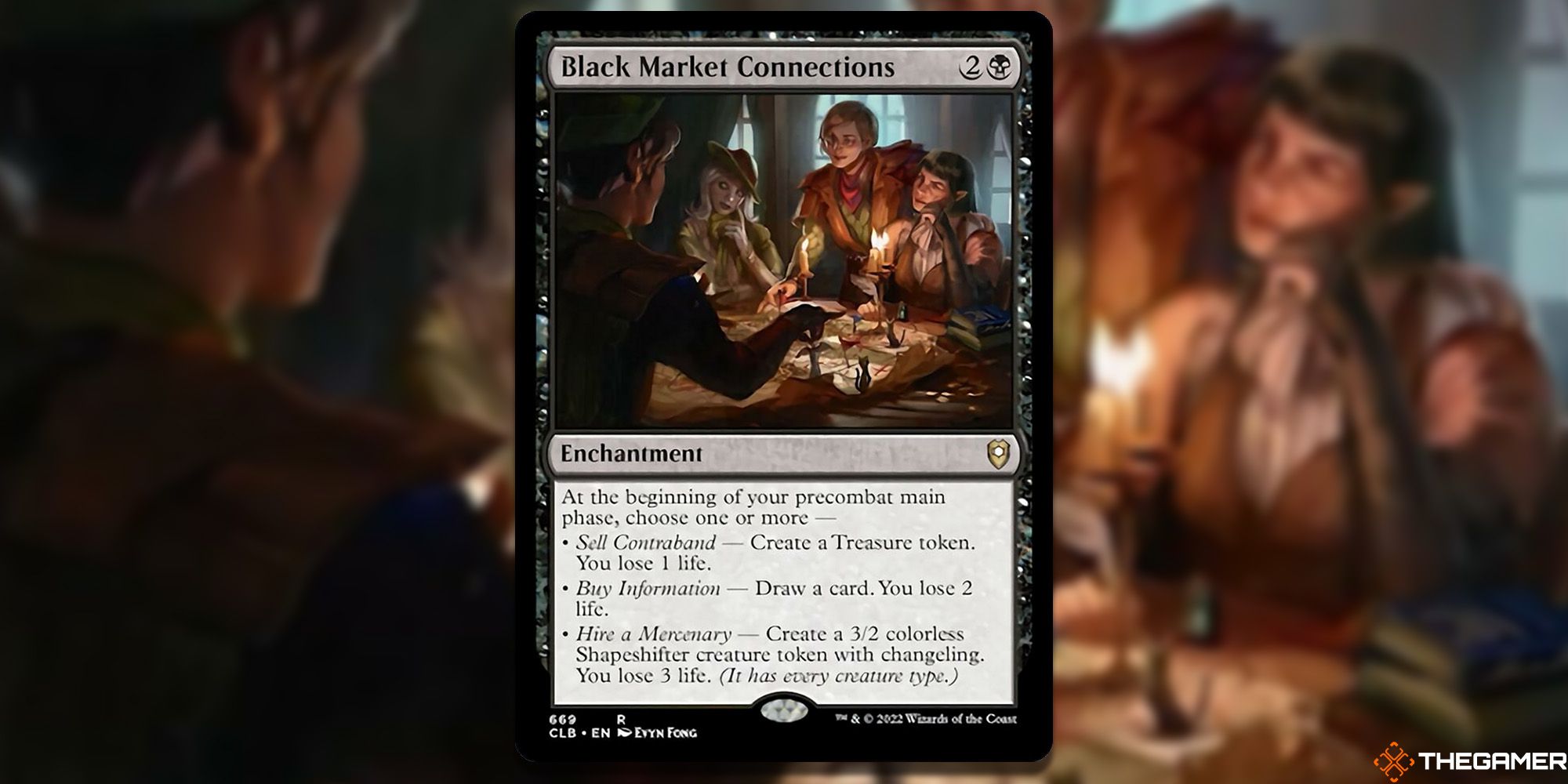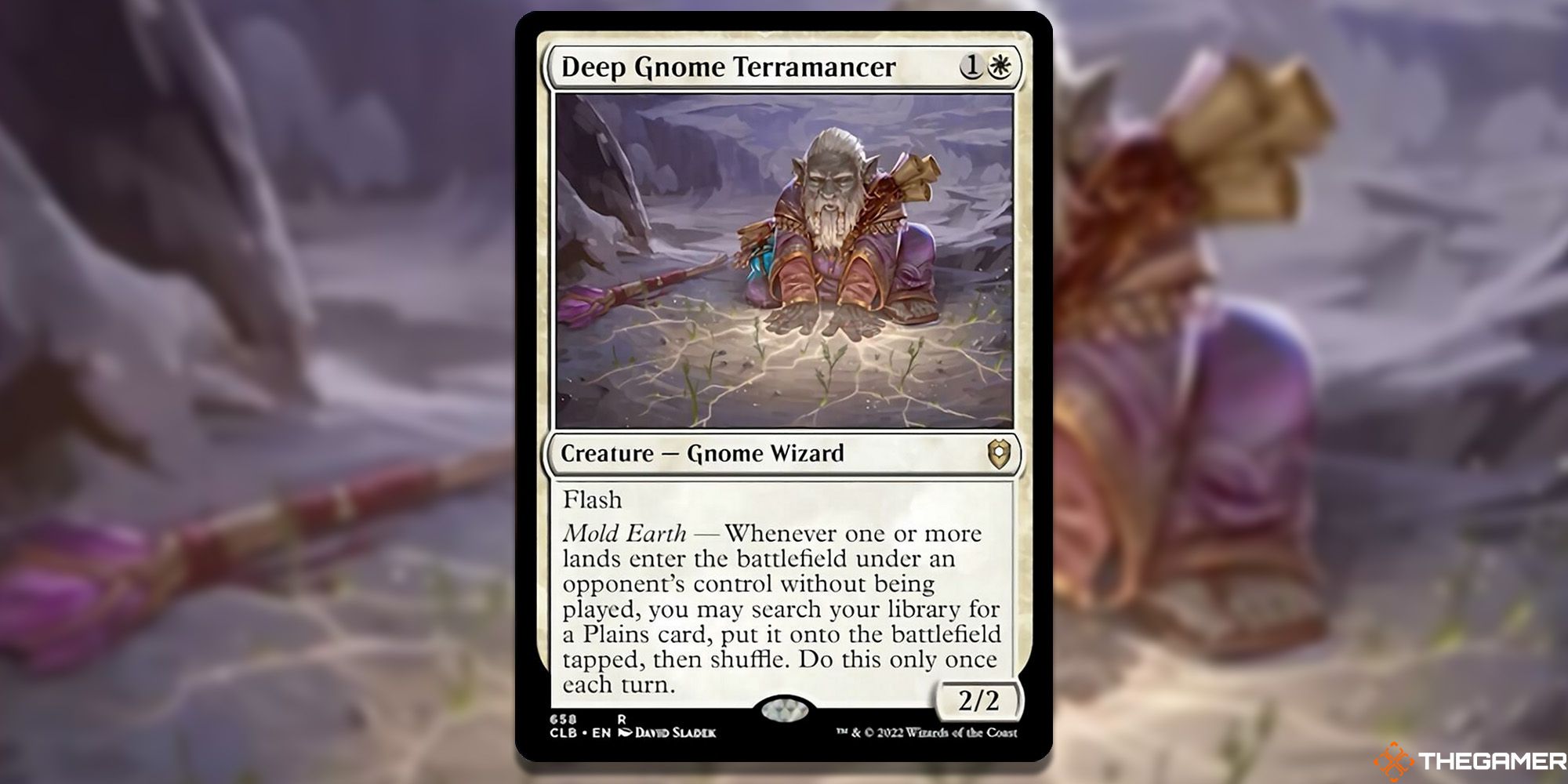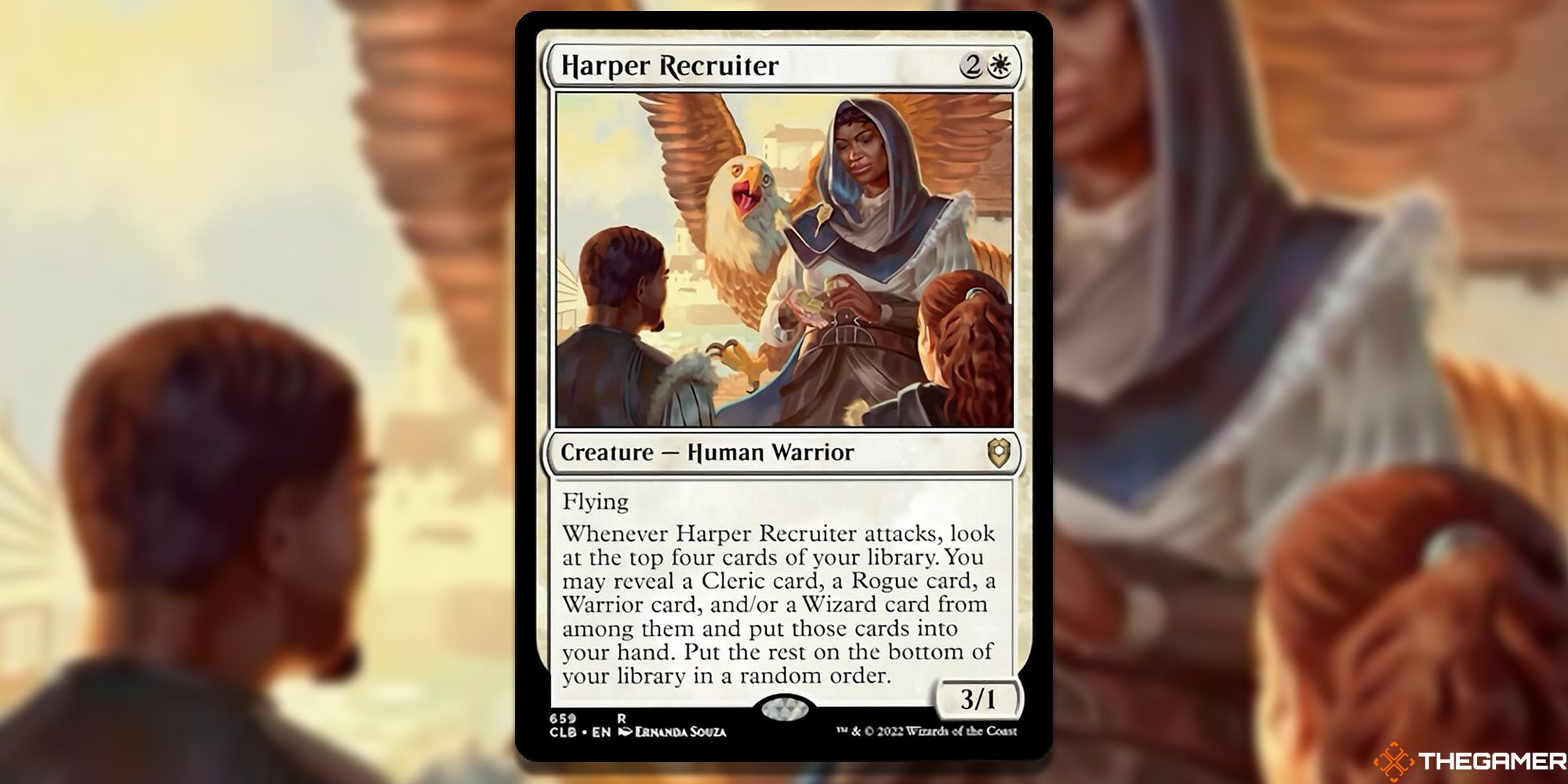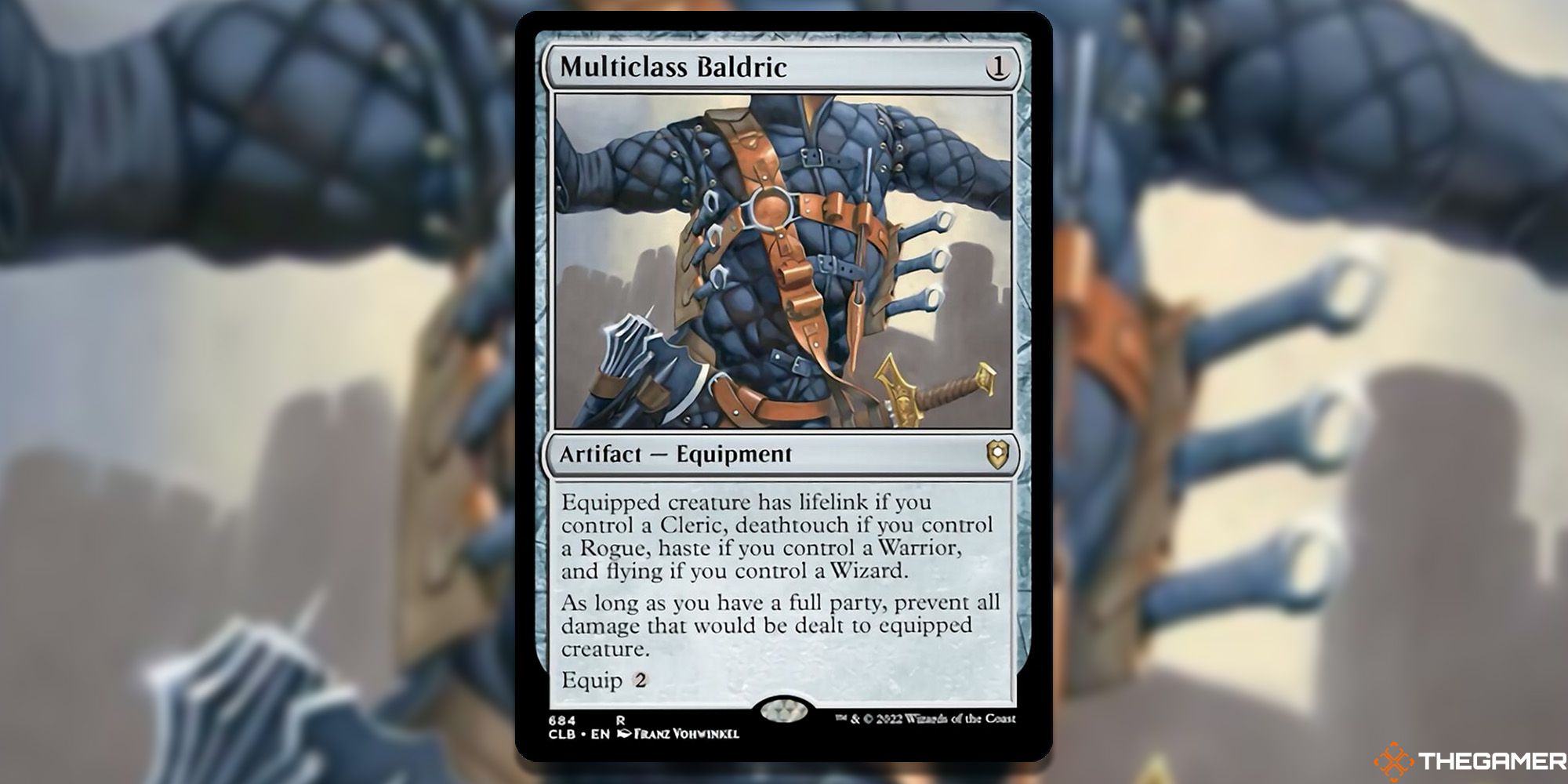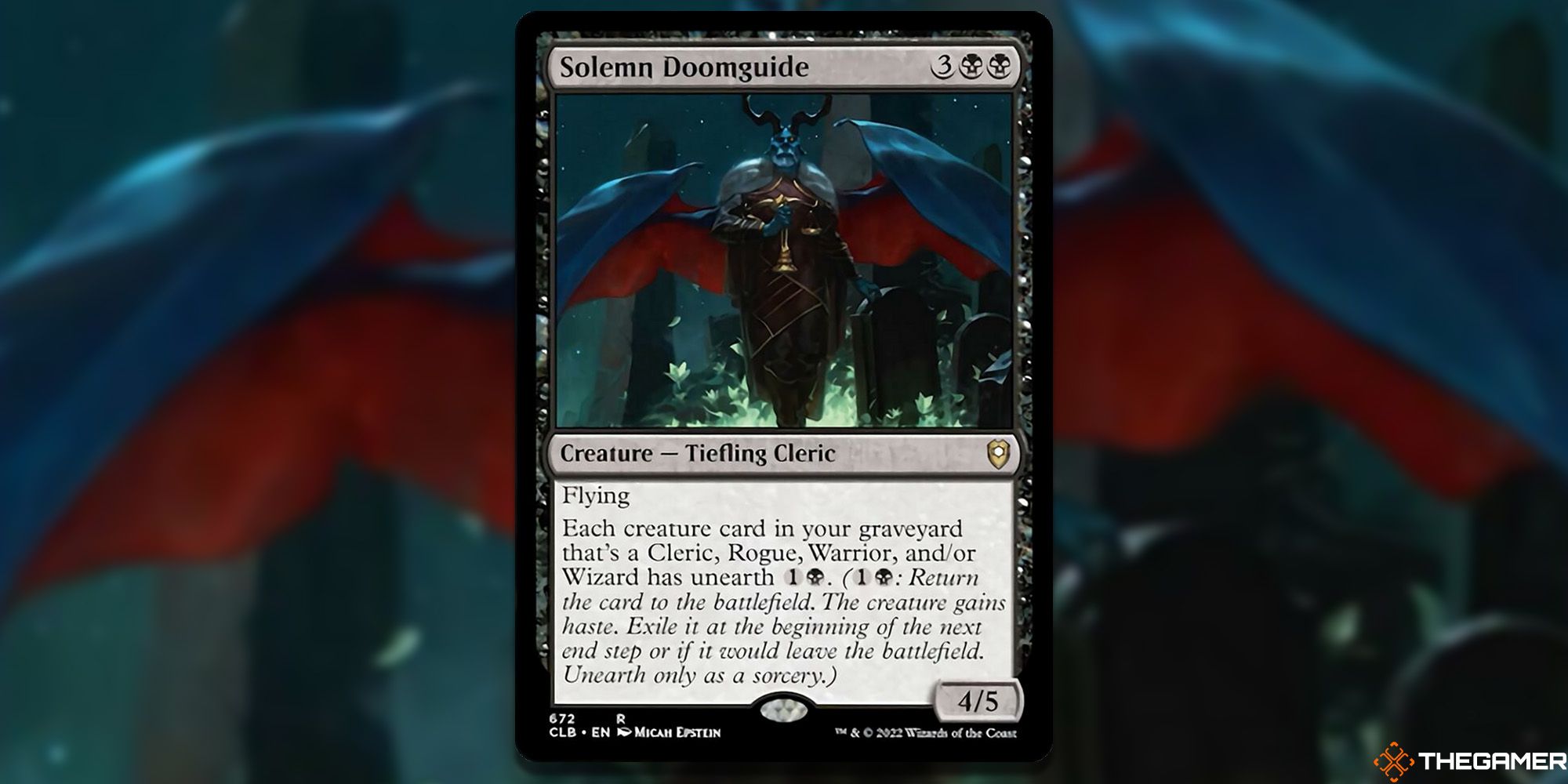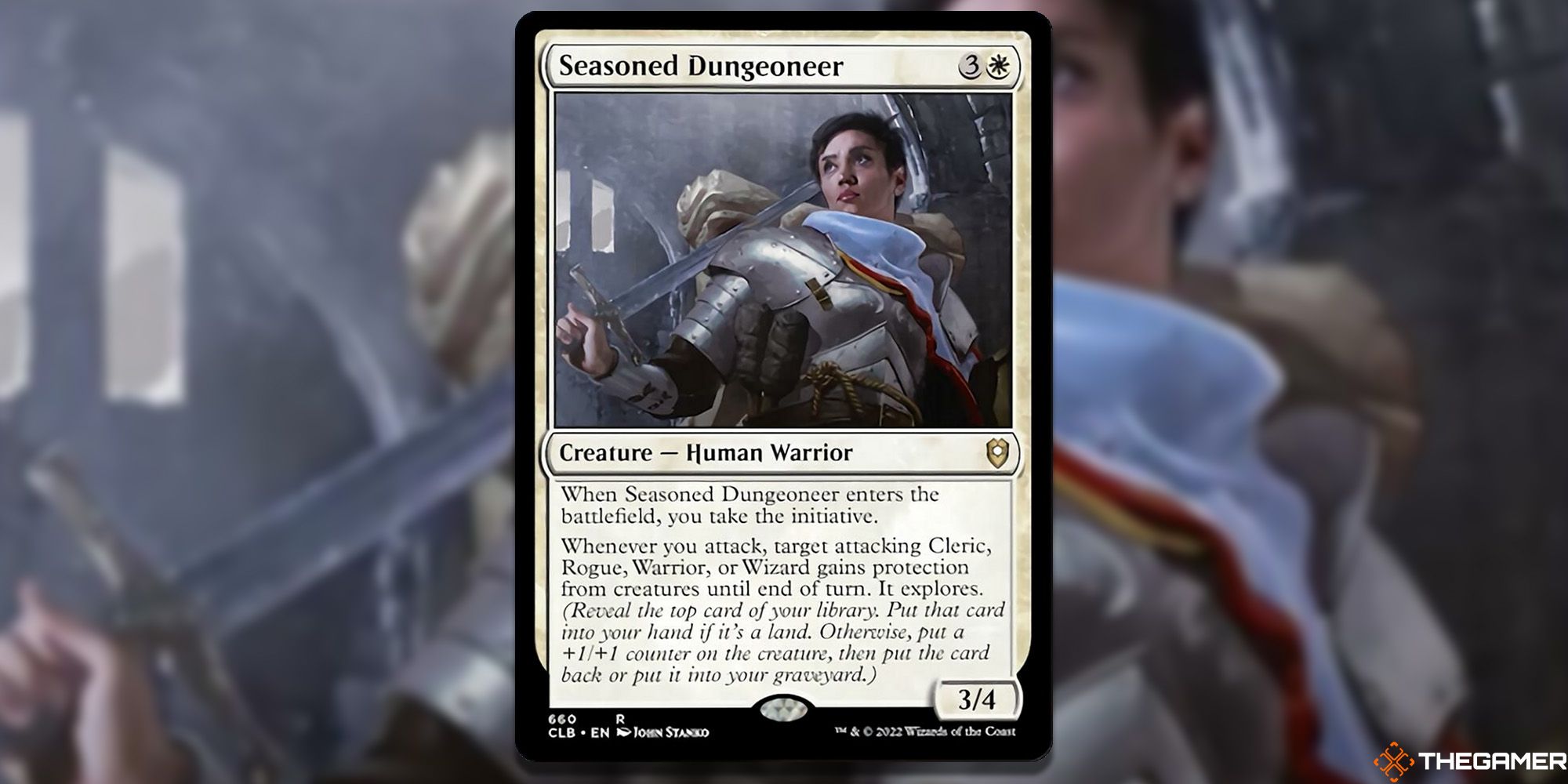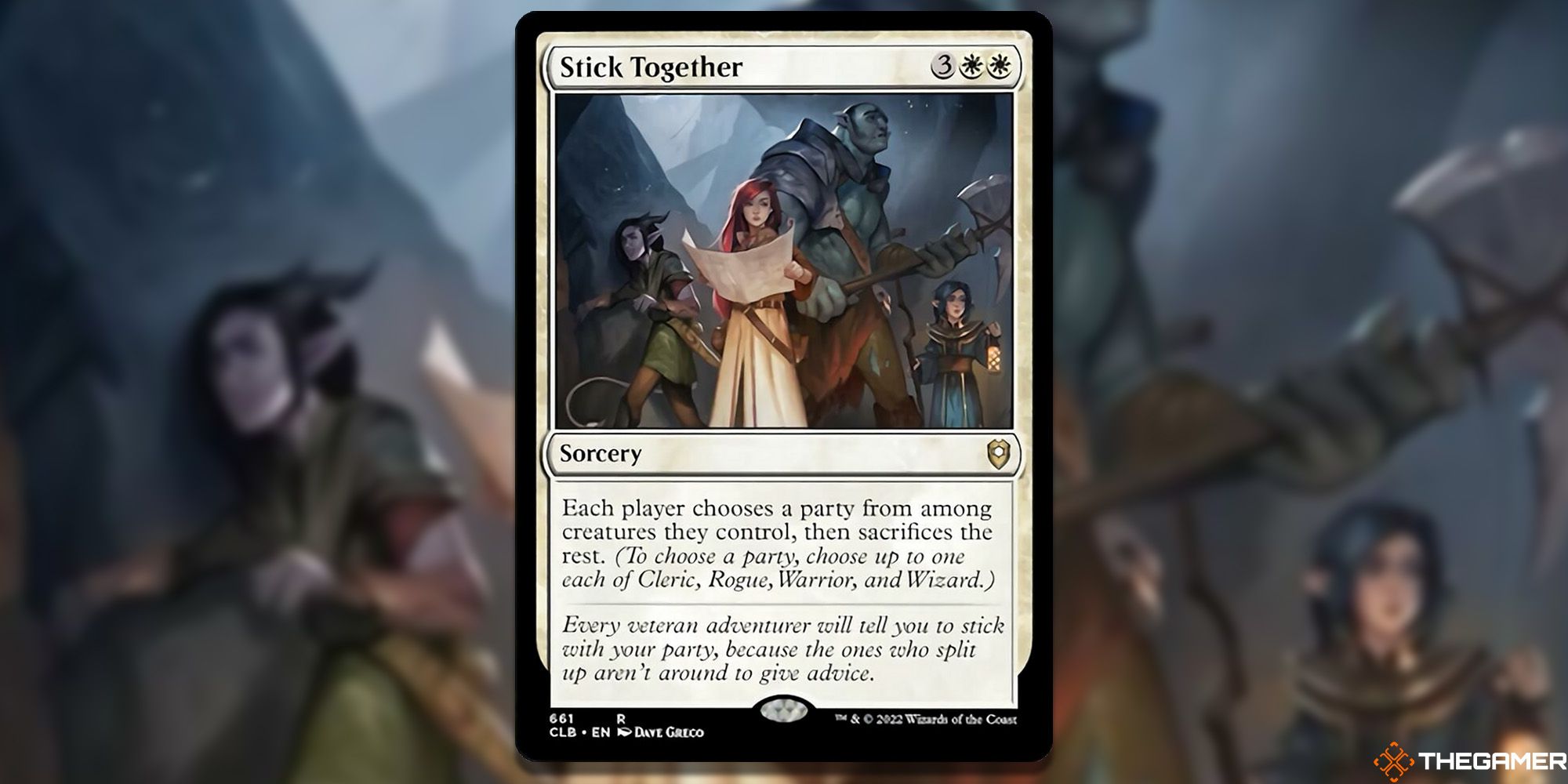Of all the mechanics not to reappear in either of Magic: The Gathering’s Dungeons & Dragons set, party was the most notable absence. A whole mechanic named after D&D’s iconic groups of adventurers seemed like a perfect fit for both Adventures in the Forgotten Realms and Commander Legends: Battle for Baldur’s Gate, and yet it got no mention in either.
Fortunately, party finally makes its triumphant return in Battle for Baldur’s Gate’s preconstructed Party Time deck. This Orzhov (black/white) deck focuses heavily on party, giving it the D&D flavour it’s desperately deserved. Here is every brand new card debuting in the deck.
Nalia de’Arnise
One generic, one white, one black legendary creature – Human Rogue – 3/3:
You may look at the top card of your library any time.
You may cast Cleric, Rogue, Warrior, and Wizard spells from the top of your library.
At the beginning of combat on your turn, if you have a full party, put a +1/+1 counter on each creature you control and those creatures gain deathtouch until end of turn.
Despite being a major part of Dungeons & Dragons, and being introduced to Magic in Zendikar Rising, the party mechanic was completely absent from Adventures in the Forgotten Realms. This is because the set had so much going on that focusing on just four creature types would have done it a disservice, but it’s still great to finally see party return for Baldur’s Gate’s Orzhov deck.
Nalia gives you easier access to your party creatures, and then buffs all of them once you’ve got all four out on the battlefield at the same once. With the new tools this deck introduces, getting a full party together will be easier than ever before. Nalia could be a fun new take on an archetype previously completely dominated by Tazri, Beacon of Unity.
Burakos, Party Leader
Three generic, one black legendary creature – Orc – 2/4:
Burakos, Party Leader is also a Cleric, Rogue, Warrior, and Wizard.
Whenever Burakos attacks, defending player loses X life and you create X Treasure tokens, where X is the number of creatures in your party.
Choose a Background.
While technically the secondary commander of the deck, Burakos likely doesn’t have enough going for it to front a deck, even with Folk Hero to back her up.
She’s great at plugging the gaps in a party with her highly flexible five creature types, but without any ways to draw into more party members without Folk Hero she pales in comparison to Nalia.
Folk Hero
One generic, one white legendary enchantment – Background:
Commander creatures you own have “Whenever you cast a spell that shares a creature type with this creature, draw a card. This ability triggers only once each turn”.
Though this is meant to be a way to speed up party decks by synergising off Burakos’ whopping five creature types, this Background also serves as a decent tool for white tribal decks of any type. Limiting it to one card per turn is let-down, but ‘disappointing card draw’ is very much a white Commander thing.
Black Market Connections
Two generic, one white enchantment:
At the beginning of your precombat main phase, choose one or more –
- Sell Contraband – Create a Treasure token. You lose one life.
- Buy Information – Draw a card. You lose two life.
- Hire a Mercenary – Create a 3/2 colourless Shapeshifter creature token with changeling. You lose three life.
It’s weird that this is a white card, as paying life for advantages is very much a black design space. And yet, for three mana you can draw a card and create an all-important Treasure token, so it’s a big boost that white really needed.
While it does make sense for the third ability to make a Shapeshifter with changeling (making them every creature type) to make parties more flexible, it feels like a repeat of the mistake Wizards made by following up Zendikar Rising’s party debut with all the changelings in Kaldheim. It somewhat cheapens the mechanic if you can just use any creature to get a full party.
Deep Gnome Terramancer
One generic, one white creature – Gnome Wizard – 2/2:
Flash.
Mold Earth – Whenever one or more lands enter the battlefield under an opponent’s control without being played, you may search your library for a Plains card, put it onto the battlefield tapped, then shuffle. Do this only once each turn.
This is easily a new staple for white Commander decks. Shooting right up there alongside cards like Land Tax and Archaeomancer’s Map, Deep Gnome Terramancer is an incredible way to benefit of an opponent ramping ahead of the board.
To explain the terminology on the card, when it says “without being played”, it merely means anything outside your usual land play each turn. Ramp spells like Cultivate or Growth Spiral will trigger Deep Gnome Terramancer, while cards that give you more land plays each turn, like Azusa, Lost But Seeking; will not.
Harper Recruiter
Two generic, one white creature – Human Warrior – 3/1:
Flying.
Whenever Harper Recruiter attacks, look at the top four cards of your library. You may reveal a Cleric card, a Rogue card, a Warrior card, and/or a Wizard card from among them and put those cards into your hand. Put the rest on the bottom of your library in a random order.
With a bit of luck (or careful deck management), Harper Recruiter could be getting you four cards into your hand whenever it attacks. In most instances, though, you’ll likely be getting one or two cards, while also running the risk of putting answers you needed at the bottom of the library.
This isn’t an amazing card in the wider Commander format, but for a party-focused one it does the job admirably.
Multiclass Baldric
One generic artifact – Equipment:
Equipped creature has lifelink if you control a Cleric, deathtouch if you control a Rogue, haste if you control a Warrior, and flying if you control a Wizard.
As long as you have a full party, prevent all damage that would be dealt to equipped creature.
Equip: two generic mana.
With Multiclass Baldric, you can bring an element of keyword soup into your party deck. The larger your party, the more keywords you have for commanders like the various iterations of Odric, and the bigger payoff you can receive.
Even without the soup angle, having a creature with lifelink, deathtouch, haste, and flying that also prevents any damage that would be dealt to it is immense. Put this on Nalia and you could be taking some players out with commander damage before anyone is able to stop you.
Solemn Doomguide
Three generic, two black creature – Tiefling Cleric – 4/5:
Flying.
Each creature card in your graveyard that’s a Cleric, Rogue, Warrior, and/or Wizard has unearth: one generic, one black.
The problem with party as a mechanic is it’s so easy for your opponent to stop you. Because you need four creatures out to get the full value of party, one player removing a single creature is enough to shut down the whole deck. With that in mind, Solemn Doomguide is an excellent way to keep your strategy trucking in the face of a board wipe or removal spell.
Unearth allows you to return a creature from the graveyard, but it gives it haste and exiles it at the end of the turn. The exile clause can be counteracted by blinking the creature (something white is good at), but you’ll generally be using this as a way to force party triggers when you don’t otherwise have the manpower for the full effect.
Seasoned Dungeoneer
Three generic, one white creature – Human Warrior – 3/4:
When Seasoned Dungeoneer enters the battlefield, you take the initiative.
Whenever you attack, target attacking Cleric, Rogue, Warrior, or Wizard gains protection from creatures until end of turn. It explores.
For many players, seeing the shiny new initiative mechanic might distract them from the absolute bomb of an ability hidden underneath it. Just by attacking, any Cleric, Rogue, Warrior, or Wizard becomes protected from all your opponent’s creatures. They can’t be targeted by abilities, and, more importantly, they can’t be blocked.
Considering we have lots of cards that make an opponent outright lose the game when they take combat damage – such as Angel of Destiny, Vorpal Sword; and Vraska, Scheming Gorgon – being able to easily slip that through with Seasoned Dungeoneer is incredible.
Explore is also a great way of ensuring you have a land to play every turn. When you explore, reveal the top card of your library. If it's a land, it goes into your hand. If it's anything else, you can put a +1/+1 counter on the exploring creature, and can decide whether to keep the card on top of your library or put it into the graveyard.
Stick Together
Three generic, two white sorcery:
Each player chooses a party from among creatures they control, then sacrifices the rest.
Is this the best white board wipe we’ve ever seen? Not at all, especially not after recent sets have introduced cards like Vanquish the Horde and Farewell. That doesn’t mean this isn’t an awesome Commander card, though, as it is such a unique take on an effect we’ve seen countless times before.
By “chooses a party”, the card is asking each player to choose a Cleric, Rogue, Warrior, and a Wizard from among the creatures they control. As party isn’t really something that can happen accidentally, a fully online party deck will easily be able to retain four creatures, while everyone else will likely lose all but maybe one of two of theirs. With a tuned deck this is an asymmetrical board wipe you could use to close out the game.

